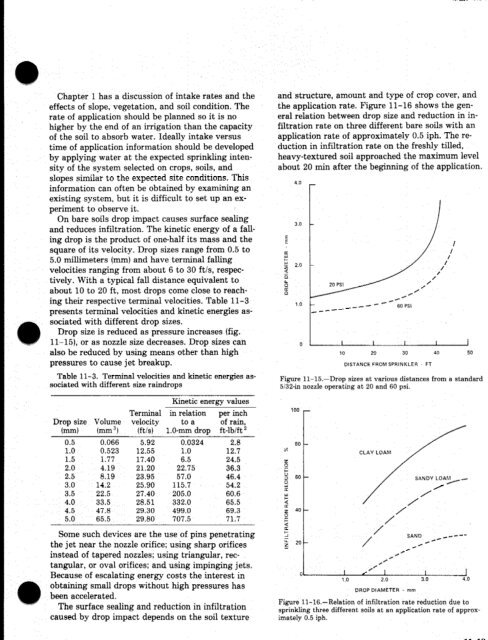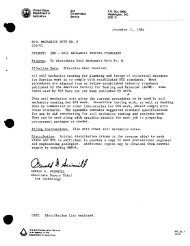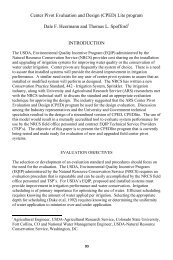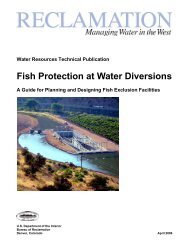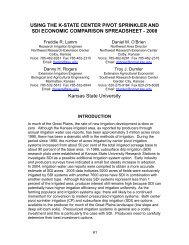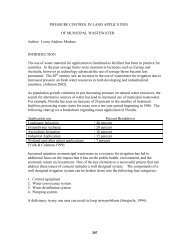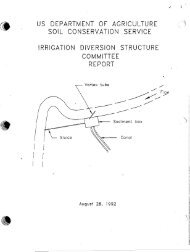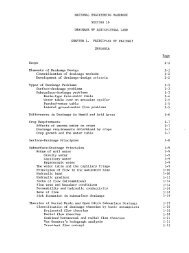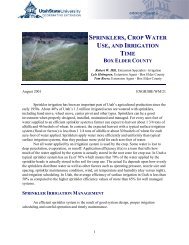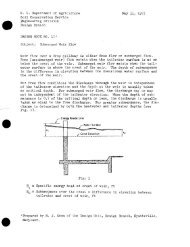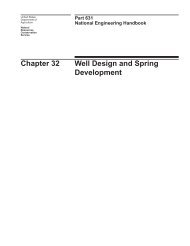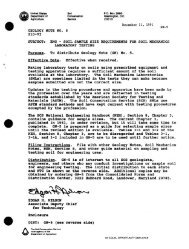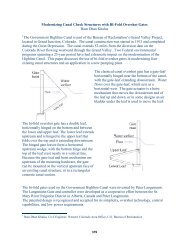Chapter 11: Sprinkle Irrigation - NRCS Irrigation ToolBox Home Page
Chapter 11: Sprinkle Irrigation - NRCS Irrigation ToolBox Home Page
Chapter 11: Sprinkle Irrigation - NRCS Irrigation ToolBox Home Page
Create successful ePaper yourself
Turn your PDF publications into a flip-book with our unique Google optimized e-Paper software.
<strong>Chapter</strong> 1 has a discussion of intake rates and the<br />
effects of slope, vegetation, and soil condition. The<br />
rate of application should be planned so it is no<br />
higher by the end of an irrigation than the capacity<br />
of the soil to absorb water. Ideally intake versus<br />
time of application information should be developed<br />
by applying water at the expected sprinkling intensity<br />
of the system selected on crops, soils, and<br />
slopes similar to the expected site conditions. This<br />
information can often be obtained by examining an<br />
existing system, but it is difficult to set up an experiment<br />
to observe it.<br />
On bare soils drop impact causes surface sealing<br />
and reduces infiltration. The kinetic energy of a falling<br />
drop is the product of one-half its mass and the<br />
square of its velocity, Drop sizes range from 0.5 to<br />
5.0 millimeters (mm) and have terminal falling<br />
velocities ranging from about 6 to 30 ftls, respectively.<br />
With a typical fall distance equivalent to<br />
about 10 to 20 ft, most drops come close to reaching<br />
their respective terminal velocities. Table <strong>11</strong>-3<br />
presents terminal velocities and kinetic energies asF<br />
sociated with different drop sizes,<br />
Drop size is reduced as pressure increases (fig,<br />
<strong>11</strong>-15), or as nozzle size decreases. Drop sizes can<br />
also be reduced by using means other than high<br />
pressures to cause jet breakup.<br />
Table <strong>11</strong>-3, Terminal velocities and kinetic energies associated<br />
with different size raindrops<br />
Kinetic energy values<br />
Terminal in relation per inch<br />
Drop size Volume velocity to a of rain,<br />
(mm) (mm3) (ftls) 1.0-mrn drop ft-lblft<br />
and structure, amount and type of crop cover, and<br />
the application rate. Figure <strong>11</strong>-16 shows the general<br />
relation between drop size and reduction in infiltration<br />
rate on three different bare soils with an<br />
application rate of approximately 0.5 iph. The reduction<br />
in infiltration rate on the freshly tilled,<br />
heavy-textured soil approached the maximum level<br />
about 20 rnin after the beginning of the application.<br />
DISTANCE FROM SPRINKLER - FT<br />
Figure Il-15.-Drop sizes at various distances from a standard<br />
5132-in nozzle operating at 20 and 60 psi.<br />
CLAY LOAM /<br />
/ SANDY LOAM, .-<br />
Some such devices are the use of pins penetrating<br />
the jet near the nozzle orifice; using sharp orifices<br />
instead of tapered nozzles; using triangular, rectangular,<br />
or oval orifices; and using impinging jets,<br />
Because of escalating energy costs the interest in<br />
obtaining small drops without high pressures has<br />
been accelerated.<br />
The surface sealing and reduction in infiltration<br />
caused by drop impact depends on the soil texture<br />
DROP DIAMETER +<br />
Figure <strong>11</strong>-16.-Relation of infiltration rate reduction due to<br />
sprinkling three different soils at an application rate of appraximately<br />
0.5 iph.<br />
mm


